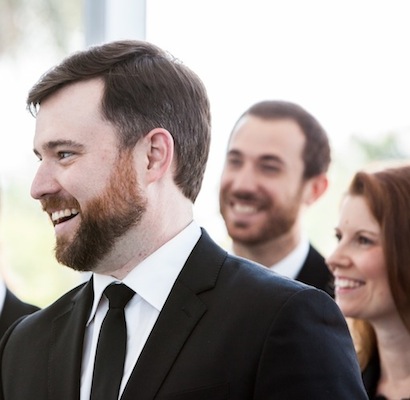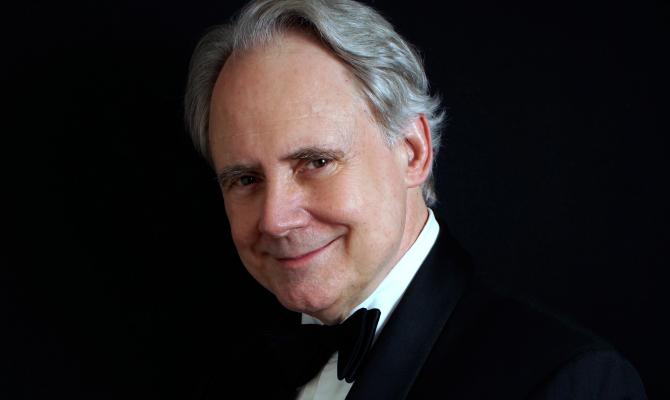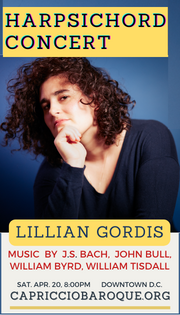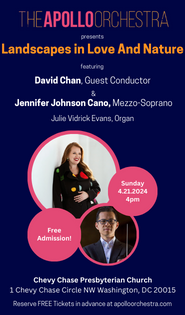Seraphic Fire’s requiem program will also mark a personal tribute

Patrick Quigley will conduct Seraphic Fire in a requiem program in Georgetown November 13.
In addition to its home concert series in South Florida, Seraphic Fire sometimes goes on the road, bringing its programs to other cities. The chamber choir, which is currently marking its 15th anniversary season, will come to the Washington area next Sunday.
Seraphic Fire’s founder and artistic director Patrick Dupré Quigley recently looked back at the group’s history and also spoke about his memories of recently departed Washington-based musical eminence, J. Reilly Lewis.
“Seraphic Fire started as a project of friends,” Quigley said. He formed the Miami-based choir with eight singers in 2001. “I look back at that first program,” he says, “and it was very much an outline of what we would make our specialty: music pre-Beethoven and music composed within the last ten years.”
By the fourth year, the musicians in the group were finishing graduate school or otherwise leaving the area. “I really didn’t want to have to start over from scratch every time,” he says. “It’s a strange thing to say, but we had built this way of breathing together, where ‘T’s’ went, and the way certain vowels were pronounced, the way ends of phrases were done. I wanted that culture to continue.”
Quigley and his colleagues decided that instead of rehearsing one day a week for eight weeks, the way a resident local group would do, they could have all of the rehearsals in four days before their concerts. “We could fly anyone in,” he explains. “We began to build what you might call the American Airlines chorus. It’s a chorus of all-stars, my very favorite choral mercenaries, people who are ‘singers of fortune’.”
The group’s name comes from a conversation he had with the composer Stephen Paulus. “Stephen said two things about starting a choir: ‘Don’t name it after yourself, and name it like a sports team.’ A lot of people don’t want to go see the Fill-in-the-Blank Chorale, because that has liturgical associations they’re not comfortable with. Name it something like The Rockets. If The Rockets are performing at a local church, well, that’s probably not at all churchy. No one’s going to proselytize me at that concert.”
Joking aside, he explains, Seraphic Fire is named after a piece by an early American composer. “The name comes from Invocation by William Billings,” he says. “The first line is, ‘Majestic God our muse inspire, Fill us with seraphic fire’. It was the first piece we performed on our first concert, and it’ll be the first piece we perform on our 15th anniversary concert.”
When asked about some of the high points of the last fifteen years, Quigley immediately recalls the group’s first performance of Bach’s Mass in B Minor. He had an ensemble of sixteen singers and a group of young instrumentalists, at that point all first- or second-year members of the New World Symphony. “For some of them it was their first time playing Bach,” he recalls. “It was my first time conducting the B-minor Mass. We were discovering this piece together. We weren’t ready for the emotional impact it would have on us. I remember at the end of it, at the Dona Nobis Pacem, where the basses play that pedal tone A and the three trumpets are at the peak of their range.”
He is clearly moved just by the memory. “I looked over and the principal flutist was crying. The continuo player was crying. One of the altos was in tears, and I was losing the feeling in the tips of my fingers. What we were doing meant something beyond just good music. That was the big bang moment, where energy started going outward instead of inward.”
Seraphic Fire will bringing the second program of its Miami season to the concert series at St. John’s Episcopal Church in Georgetown November 13. “That program is our collaboration with Nathan Laube,” says Quigley, “perhaps the best young organist anywhere, just a stunningly good player. He just got back from a 20-city tour of the best historical organs in Europe.” Laube will accompany Seraphic Fire in the Requiem Masses by both Gabriel Fauré and Maurice Duruflé, in versions for organ.
“The Duruflé is, for me, the Desert Island piece,” Quigley says with considerable enthusiasm. “I grew up in New Orleans. French organ improvisation on Gregorian chant is what I grew up with. I learned to chant the Ave Maria in second grade.
“The Duruflé Requiem for me takes all of that and marries it with new music. Those first two beats are so wondrous, as the Requiem chant appears so inevitably out of two quarter notes worth of organ music, it blows my mind.” He pauses. “Some people light incense; I listen to the Duruflé Requiem.”
To celebrate its 15th anniversary, Seraphic Fire has commissioned eight composers to create new works especially for them this season. Quigley says that he wanted the pieces to be, as much as possible, something that choirs other than Seraphic Fire could also perform, not something so specialized that only they could perform it. “Along with the Duruflé and Fauré on this concert, we are also doing a new piece that Doug Cuomo, the composer who wrote the opera Doubt, has written for us.”
“It is going to be the one-year anniversary of the Paris attacks when we perform this concert,” Quigley explains. “This happened completely by chance. Doug’s piece is a Requiem for victims of oppression. He is an outrageously good composer, so in touch with humanity. He has no pretensions. He is just a guy who wants to write music that says something.”
Although Quigley still works with Seraphic Fire principally in Miami, he now lives in Washington with his husband, whose work is here. “It takes me four hours and fifteen minutes, door to door, to get back to Miami,” he says. “I lived in Miami for a long time, but it’s a wonderful thing to get to experience a new place, and especially a new place where you can go to concerts. And I am not necessarily the one doing the concert!”
There is another unforeseen connection in this concert of two Masses for the dead, as Quigley explains. “When I first moved to D.C. one of the people who was by far the most supportive of me, the person who went out of his way to make me feel welcome, was J. Reilly Lewis,” he recounts. “Although I didn’t know him from Adam, Reilly sat in on every one of my sound checks.”

J. Reilly Lewis
Lewis’s sudden death last June, from a massive heart attack, shocked the entire music community of Washington. “A friend of mine told me that Reilly was dead,” Quigley recalls, “and I said, ‘What are you talking about?’ I was in the midst of an email chain with Reilly about when we were going to get together for lunch when I was back in town.”
The venue for this concert, St. John’s Episcopal Church in Georgetown, had a new pipe organ installed in 2012. Built by Casavant Frères in Quebec, the new instrument was donated by parishioners John and Dariel Van Wagoner, whose daughter is Reilly Lewis’s widow.
“He was always this giving, giving, giving person,” Quigley says with admiration, “and his wife’s family gave this excellent organ at St. John’s. From a personal standpoint, it’s profound to get to do those pieces, and to do them on an organ given by Reilly’s family.
“We’re going to perform two Requiems on this concert. I don’t know anything better to do for Reilly than to do a good job with this.”
Seraphic Fire performs 5 p.m. November 13 at St. John’s Episcopal Church in Georgetown. stjohnsgeorgetown.org/georgetown-concert-series/
Charles T. Downey is associate editor of Washington Classical Review. He also reviews concerts and recordings for the Washington Post and is a long-time observer of classical music and the arts in the nation’s capital at his pioneering blog ionarts.org, established in 2003.






